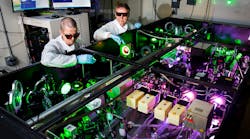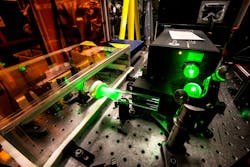The United States is upgrading its laser capabilities with Zeus, a three-petawatt device to be built at the University of Michigan. (Three petawatts is equal to three quadrillion watts, or a 3 followed by 15 zeros.)
The $16 million laser will be used for basic and applied research. It will test a leading theory on how the universe operates at a subatomic level, which could lead to advancements in medicine, materials science, and national security. Zeus will be a “user facility”, giving scientists and engineers across the country access to extreme laser intensities.
“This laser will have the highest peak power in the U.S. and will be among the world’s most powerful laser systems for the next decade,” says Karl Krushelnick, director of the Gérard Mourou Center for Ultrafast Optical Science at UM, where the laser will be built.
The U.S. built the world’s first petawatt laser in 1996, but hasn’t kept pace with more ambitious lasers under construction elsewhere in the world. These include a pair of 10-petawatt lasers in Europe and a 5.3-petawatt laser in China, which also has plans to build a 100-petawatt device.
The initial 300-TW Hercules laser on which Zeus is based. (Courtesy: Joseph Xu, College of Engineering, University of Michigan)
Getting back into the game with a 3-petawatt laser for $16 million is a bargain. The cost savings comes in part because some high-power laser components are now produced commercially, so they don’t need to be custom-built. In addition, Zeus is an upgrade of an existing 0.5-petawatt laser, known for roughly two decades as Hercules.
One of the signature experiments planned for the new laser will have it shoot the laser at a high-energy electron beam going the opposite direction. This way, researchers will be able to mimic a much more powerful zettawatt laser (that’s 1 quintillion watts, or a 1 followed by 21 zeros). With this capability, the UM laser could examine quantum electrodynamics, the reigning explanation of how the universe operates at the subatomic level.
“Quantum electrodynamics is a successful theory and has been accurate every time it has been measured in the laboratory. We hope to explore the more extreme regimes, where there is much more uncertainty in the theoretical predictions,” says Krushelnick, a professor of nuclear engineering and radiological sciences, electrical engineering and computer science, and physics.
For instance, quantum electrodynamics predicts how Zeus’ high-intensity beams could affect a vacuum, which is essentially the underlying fabric of spacetime. Rather than being simple nothingness, a vacuum does strange things when a high electric field is concentrated in one location. Pulses from the laser, scattering from the electron beam, should be strong enough to make matter and antimatter—pairs of electrons and positrons—suddenly appear from nothing. This has been called “boiling the vacuum.”
Quantum electrodynamics also predicts that the electric field from the laser could become so strong that it makes the vacuum behave like a lens for light.
In addition to these fundamental questions, Zeus could help develop methods and technologies for use in medicine, defense, materials science, and astrophysics, such as:
- Making advanced cancer therapies more widely available to patients by shrinking the accelerators needed to generate proton beams and radioactive isotopes.
- Improving detection of nuclear-weapon materials in shipping containers.
- Exploring how materials change on fast timescales.
- Providing new insights into black holes by exploring the high-energy electron-positron jets they are believed to emit.


